Will There Be Flying Cars In 2025? This is a question on many minds, and flyermedia.net is here to provide some answers. The concept of personal air travel is closer than ever, with advancements in electric vertical takeoff and landing (eVTOL) technology and urban air mobility (UAM) initiatives paving the way for a future where flying cars could become a reality. Explore aerospace innovations, aviation industry trends, and the practicality of air transport on flyermedia.net.
1. What Exactly Defines a “Flying Car” Anyway?
Defining a flying car isn’t as straightforward as it seems. It’s more than just a car that can fly; it’s a blend of automotive and aviation technology.
- A Dual-Purpose Vehicle: A true flying car should ideally be capable of both road travel and flight, offering seamless transitions between the two modes.
- VTOL Capability: Vertical Take-Off and Landing (VTOL) is a key feature, allowing these vehicles to operate in urban environments without the need for long runways.
- Autonomous Flight: Many concepts envision autonomous or semi-autonomous flight capabilities, making personal air travel accessible to a wider audience.
- Electric Propulsion: With the rise of electric vehicles, many flying car prototypes are focusing on electric propulsion for cleaner and quieter operation.
The term “flying car” encompasses a wide range of vehicles, from those resembling traditional cars with added flight capabilities to more aircraft-like designs optimized for aerial transport.
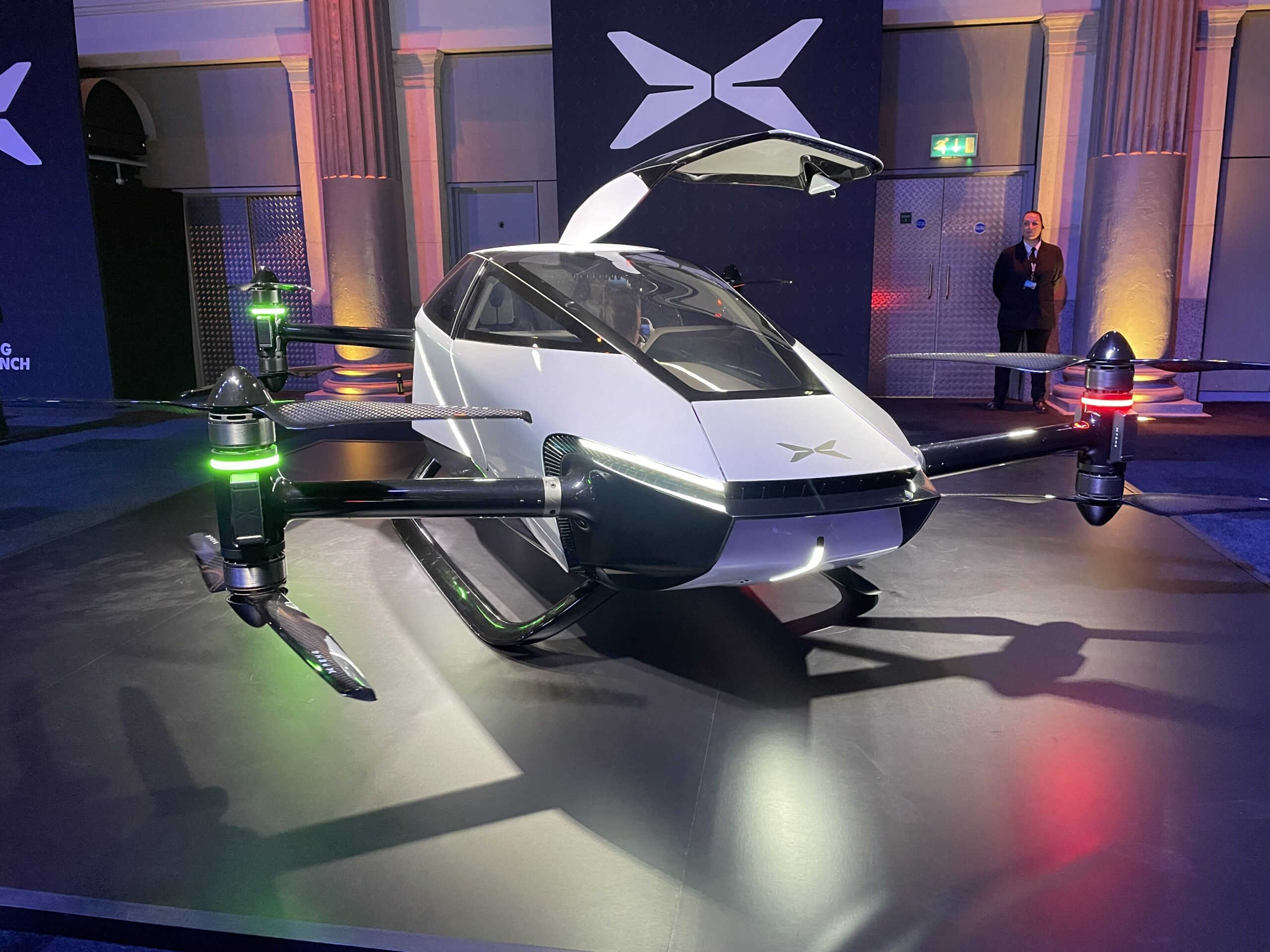 XPENG X2 flying car
XPENG X2 flying car
2. Who are the Key Players in the Flying Car Industry?
The flying car industry is buzzing with innovation, attracting both established automotive giants and ambitious startups. Here are some of the major players:
- XPENG AEROHT: This Chinese company has been making waves with its X2 flying car and Land Aircraft Carrier concept, showcasing their commitment to urban air mobility.
- SkyDrive: A Japanese company working in conjunction with Suzuki, SkyDrive has been testing its three-seater eVTOL and pursuing certification in Japan and the U.S.
- Joby Aviation: Backed by Toyota, Joby Aviation is developing a tilt-rotor eVTOL aircraft with impressive speed and range capabilities.
- Honda: Honda is entering the eVTOL market with a hybrid design that combines a gas turbine engine with F1-derived battery technology.
- Hyundai Supernal: Hyundai’s Supernal division is developing the S-A2, an eVTOL targeting short urban journeys with speeds up to 120 mph.
- BMW Skai: BMW has partnered with Skai to design a hydrogen fuel cell-powered eVTOL with a focus on safety and range.
- Archer Aviation: Partnering with Stellantis, Archer Aviation is developing the Midnight, a large eVTOL designed for shorter flights.
- Toyota: Through significant investment in Joby Aviation, Toyota is heavily involved in the development of eVTOL technology.
- Boeing: Although their collaboration with Porsche on a flying car project seems to have stalled, Boeing’s expertise in aerospace makes them a key player in the broader UAM landscape.
These companies are pushing the boundaries of technology and design, each with their unique approach to creating a viable flying car.
3. What Technological Advancements are Making Flying Cars Possible?
Several key technological advancements are converging to make flying cars a tangible possibility:
- Electric Propulsion: Advancements in battery technology and electric motors are enabling quieter, more efficient, and environmentally friendly flight.
- VTOL Technology: Electric Vertical Take-Off and Landing (eVTOL) technology eliminates the need for runways, making flying cars practical for urban environments.
- Autonomous Flight Systems: Advanced sensors, GPS, and AI algorithms are paving the way for autonomous or semi-autonomous flight, simplifying operation and enhancing safety.
- Advanced Materials: Lightweight and strong materials like carbon fiber are crucial for building aircraft that can carry passengers and cargo efficiently.
- Improved Air Traffic Management: New systems are being developed to manage the increased air traffic that flying cars will bring, ensuring safe and efficient operation.
These technological leaps are driving the development of flying cars from science fiction to engineering reality.
4. What are the Potential Benefits of Flying Cars?
Flying cars offer a range of potential benefits that could revolutionize transportation and urban living:
- Reduced Congestion: By taking to the skies, flying cars can bypass ground traffic, alleviating congestion and shortening commute times.
- Increased Accessibility: Flying cars can provide access to remote areas that are difficult to reach by traditional transportation methods.
- Faster Travel Times: For longer distances, flying cars can offer significantly faster travel times compared to driving or public transport.
- Economic Growth: The flying car industry has the potential to create new jobs and stimulate economic growth in manufacturing, technology, and infrastructure.
- Emergency Services: Flying cars can be used for rapid response in emergency situations, such as search and rescue operations or medical transport.
These benefits make flying cars an attractive solution for addressing many of the challenges facing modern transportation systems.
5. What are the Challenges Facing the Development of Flying Cars?
Despite the potential benefits, significant challenges remain before flying cars become a mainstream reality:
- Regulatory Hurdles: Establishing clear regulations and safety standards for flying cars is a complex process that requires collaboration between governments and industry stakeholders.
- Safety Concerns: Ensuring the safety and reliability of flying cars is paramount, requiring rigorous testing and fail-safe systems.
- Infrastructure Requirements: Developing the necessary infrastructure, such as vertiports (landing and takeoff pads), charging stations, and air traffic management systems, is a major undertaking.
- Public Acceptance: Overcoming public skepticism and concerns about noise, safety, and privacy is crucial for the widespread adoption of flying cars.
- Cost: Making flying cars affordable for the average consumer is a significant challenge, requiring advancements in manufacturing and technology.
Addressing these challenges will require sustained effort, innovation, and collaboration across various sectors.
6. What is the Current Regulatory Landscape for Flying Cars in the US?
The regulatory landscape for flying cars in the US is evolving rapidly, with the FAA playing a central role.
- FAA Oversight: The FAA is responsible for regulating the safety of civil aviation in the US, including the certification and operation of flying cars.
- Certification Process: Flying car manufacturers must undergo a rigorous certification process to ensure their vehicles meet safety standards.
- Air Traffic Management: The FAA is working on developing new air traffic management systems to accommodate the increased air traffic that flying cars will bring.
- State and Local Regulations: In addition to federal regulations, state and local governments may also have their own rules regarding the operation of flying cars.
The FAA is taking a proactive approach to regulating flying cars, recognizing the potential benefits of this technology while prioritizing safety.
7. When Can We Realistically Expect to See Flying Cars in the Skies?
Predicting the exact timeline for the widespread adoption of flying cars is challenging, but here’s a realistic outlook:
- Limited Commercial Operations by 2025-2028: Some companies are aiming to launch limited commercial operations in select cities by the mid to late 2020s.
- Gradual Expansion in the 2030s: As regulations become clearer and technology matures, we can expect to see a gradual expansion of flying car services in the 2030s.
- Mainstream Adoption Beyond 2040: Widespread adoption of flying cars is likely to occur beyond 2040, as costs come down and infrastructure develops.
While it’s unlikely that flying cars will be a common sight in 2025, significant progress is being made, and the future of personal air travel is closer than ever.
8. What is the Expected Cost of Flying Cars?
The cost of flying cars is a major factor that will determine their accessibility and adoption rate.
- High Initial Cost: Early models of flying cars are expected to be expensive, likely costing hundreds of thousands or even millions of dollars.
- Economies of Scale: As production volumes increase and technology matures, the cost of flying cars is expected to decrease over time.
- Operating Costs: In addition to the initial purchase price, operating costs such as electricity, maintenance, and insurance will also need to be considered.
- Ride-Sharing Services: One potential model for making flying cars more accessible is through ride-sharing services, where users can pay for individual flights rather than owning the vehicle.
The high cost of flying cars is a significant barrier to entry, but technological advancements and innovative business models could make them more affordable in the future.
9. How Will Flying Cars Impact Urban Planning and Infrastructure?
The introduction of flying cars will have a profound impact on urban planning and infrastructure:
- Vertiports: Cities will need to build vertiports, which are specialized landing and takeoff pads for flying cars, strategically located throughout urban areas.
- Air Traffic Corridors: Designated air traffic corridors will need to be established to ensure the safe and efficient flow of flying cars.
- Noise Reduction: Urban planners will need to consider the noise impact of flying cars and implement measures to minimize disturbance to residents.
- Integration with Existing Transportation Systems: Flying cars will need to be integrated with existing transportation systems, such as public transit and ride-sharing services.
- Land Use: The availability of vertical transportation could impact land use patterns, potentially leading to more compact and efficient urban development.
The integration of flying cars into urban environments will require careful planning and coordination to maximize their benefits and minimize their potential drawbacks.
 XPENG Land Carrier 2
XPENG Land Carrier 2
10. What are the Environmental Considerations of Flying Cars?
The environmental impact of flying cars is a complex issue with both potential benefits and drawbacks:
- Electric Propulsion: Many flying car designs utilize electric propulsion, which can reduce greenhouse gas emissions compared to traditional gasoline-powered vehicles.
- Noise Pollution: Flying cars have the potential to generate noise pollution, especially in densely populated urban areas.
- Energy Consumption: The energy consumption of flying cars will depend on factors such as vehicle design, flight patterns, and energy source.
- Manufacturing and Disposal: The environmental impact of manufacturing and disposing of flying cars will need to be considered.
- Urban Sprawl: The availability of flying cars could potentially contribute to urban sprawl, as people may be more willing to live further from city centers.
A comprehensive assessment of the environmental impact of flying cars is needed to ensure that this technology is deployed in a sustainable manner.
11. What Career Opportunities Will Emerge in the Flying Car Industry?
The flying car industry is poised to create a wide range of exciting career opportunities:
- Aircraft Designers and Engineers: Designing and developing the next generation of flying cars will require skilled engineers with expertise in aerospace, electrical, and mechanical engineering.
- Software Developers: Developing the software and algorithms that control autonomous flight systems will be a critical role.
- Manufacturing Technicians: As production ramps up, skilled technicians will be needed to manufacture and assemble flying cars.
- Pilots and Operators: While many flying cars are designed to be autonomous, trained pilots and operators will still be needed for certain applications.
- Air Traffic Controllers: Managing the increased air traffic that flying cars will bring will require skilled air traffic controllers.
- Maintenance Technicians: Ensuring the safety and reliability of flying cars will require skilled maintenance technicians.
- Vertiport Managers: Operating and managing vertiports will create new job opportunities in facility management and customer service.
The flying car industry offers a wealth of exciting career opportunities for individuals with a passion for aviation, technology, and innovation.
12. How Are Legacy Car Makers Involved in Flying Car Development?
Legacy car makers are playing an increasingly important role in the development of flying cars, bringing their expertise in manufacturing, design, and technology to the table.
- Toyota’s Investment in Joby Aviation: Toyota has invested over a billion dollars in Joby Aviation, demonstrating their commitment to eVTOL technology.
- Stellantis’ Partnership with Archer Aviation: Stellantis is partnering with Archer Aviation to manufacture the Midnight eVTOL.
- Honda’s Hybrid eVTOL Project: Honda is developing its own hybrid eVTOL using technology from its HondaJet and Formula 1 programs.
- BMW’s Design Collaboration with Skai: BMW has lent its design expertise to the Skai hydrogen fuel cell-powered eVTOL.
- Suzuki’s Collaboration with SkyDrive: Suzuki is working with SkyDrive on the development of their three-seater eVTOL.
These partnerships and projects demonstrate the growing interest of legacy car makers in the flying car market.
 SkyDrive Suzuki flying car
SkyDrive Suzuki flying car
13. What Role Will Artificial Intelligence (AI) Play in Flying Cars?
Artificial intelligence (AI) will play a critical role in the development and operation of flying cars:
- Autonomous Flight Control: AI algorithms will be essential for enabling autonomous flight, allowing flying cars to navigate and avoid obstacles without human intervention.
- Air Traffic Management: AI can be used to optimize air traffic flow, reducing congestion and improving safety.
- Predictive Maintenance: AI can analyze data from sensors to predict potential maintenance issues, reducing downtime and improving reliability.
- Personalized User Experience: AI can be used to personalize the user experience, such as adjusting flight settings based on passenger preferences.
- Real-time Decision Making: AI can enable flying cars to make real-time decisions in response to changing conditions, such as weather or traffic.
AI is a key enabler of the flying car revolution, making it possible to create safe, efficient, and user-friendly air transportation systems.
14. How Will Flying Cars Impact Emergency Response Services?
Flying cars have the potential to revolutionize emergency response services:
- Faster Response Times: Flying cars can reach emergency situations much faster than traditional ground vehicles, potentially saving lives.
- Access to Remote Areas: Flying cars can provide access to remote areas that are difficult to reach by other means.
- Medical Transport: Flying cars can be used to transport patients to hospitals quickly, improving outcomes in critical situations.
- Search and Rescue Operations: Flying cars can be used to search for missing persons or to rescue people from dangerous situations.
- Disaster Relief: Flying cars can be used to deliver supplies and personnel to disaster-stricken areas.
The ability of flying cars to overcome traffic congestion and reach remote locations quickly makes them a valuable asset for emergency response services.
15. How Can I Prepare for a Career in the Flying Car Industry?
If you’re interested in a career in the flying car industry, here are some steps you can take to prepare:
- Education: Pursue a degree in aerospace engineering, electrical engineering, mechanical engineering, computer science, or a related field.
- Gain Relevant Experience: Seek internships or entry-level positions in the aviation, automotive, or technology industries.
- Develop Technical Skills: Focus on developing skills in areas such as CAD software, programming, robotics, and AI.
- Stay Up-to-Date: Follow industry news and developments to stay informed about the latest trends and technologies.
- Network: Attend industry events and connect with professionals in the field.
- Consider Certifications: Obtain certifications in relevant areas, such as aviation maintenance or drone operation.
With the right education, experience, and skills, you can position yourself for a rewarding career in the exciting and rapidly growing flying car industry.
16. Are Flying Cars Just a Fad, or Are They Here to Stay?
While the concept of flying cars has been around for decades, recent advancements in technology and growing investment in the industry suggest that they are more than just a fad.
- Technological Advancements: Electric propulsion, VTOL technology, and autonomous flight systems are making flying cars more practical and feasible than ever before.
- Growing Investment: Major automakers, technology companies, and venture capitalists are investing heavily in the development of flying cars.
- Urbanization and Congestion: The increasing urbanization and traffic congestion in cities around the world are creating a need for alternative transportation solutions.
- Potential Benefits: The potential benefits of flying cars, such as reduced congestion, faster travel times, and increased accessibility, are driving innovation and development.
- Regulatory Support: Governments around the world are working to establish regulations and safety standards for flying cars, paving the way for their commercialization.
While challenges remain, the convergence of these factors suggests that flying cars are here to stay and will play an increasingly important role in the future of transportation.
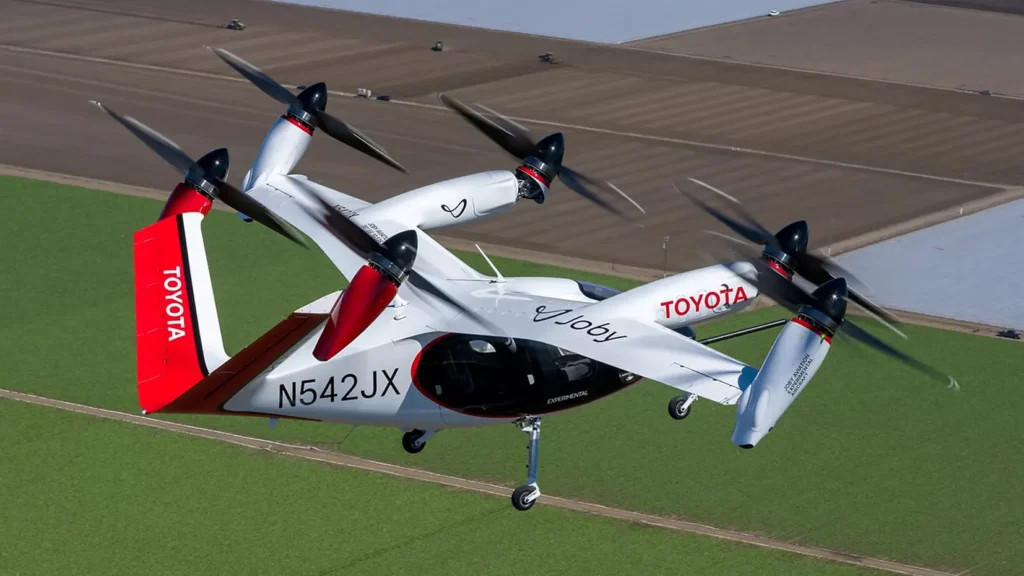 Toyota / Joby eVTOL flying car
Toyota / Joby eVTOL flying car
17. What is the Role of Drone Technology in Flying Car Development?
Drone technology is playing a crucial role in the development of flying cars:
- Testing and Prototyping: Drones are being used to test and prototype new technologies and designs for flying cars.
- Autonomous Flight Systems: The autonomous flight systems used in drones are being adapted for use in flying cars.
- Sensor Technology: The sensor technology used in drones, such as lidar and cameras, is being used to improve the safety and reliability of flying cars.
- Air Traffic Management: The air traffic management systems being developed for drones are helping to pave the way for the integration of flying cars into the airspace.
- Pilot Training: Drone pilot training programs are providing a foundation for the training of flying car pilots.
Drone technology is providing a valuable platform for the development and testing of key technologies for flying cars, accelerating their progress towards commercialization.
18. What are Vertiports, and Why Are They Important?
Vertiports are specialized landing and takeoff pads for vertical takeoff and landing (VTOL) aircraft, including flying cars. They are essential for the successful deployment of flying cars in urban environments.
- Safe and Efficient Operations: Vertiports provide a safe and efficient location for flying cars to take off and land.
- Charging and Maintenance: Vertiports can be equipped with charging stations and maintenance facilities to support the operation of flying cars.
- Passenger Terminals: Vertiports can serve as passenger terminals, providing a convenient and comfortable waiting area for passengers.
- Integration with Transportation Systems: Vertiports can be integrated with existing transportation systems, such as public transit and ride-sharing services.
- Urban Planning: The location and design of vertiports will need to be carefully considered to minimize noise and visual impact on surrounding communities.
The development of a network of vertiports is a critical step in making flying cars a practical and viable transportation solution.
19. How Will Flying Cars Affect the Airline Industry?
Flying cars have the potential to disrupt the airline industry in several ways:
- Short-Distance Travel: Flying cars could become a competitive alternative to airlines for short-distance travel, especially between cities within a few hundred miles.
- Regional Airports: Flying cars could provide a more convenient and affordable way to access regional airports, increasing their utilization.
- New Business Models: The emergence of flying cars could lead to new business models in the airline industry, such as on-demand air taxi services.
- Congestion Relief: By taking some of the pressure off of traditional airports, flying cars could help to alleviate congestion and improve efficiency.
- Innovation: The development of flying cars could spur innovation in the airline industry, leading to new technologies and services.
While it’s unlikely that flying cars will completely replace airlines, they have the potential to significantly alter the landscape of the air travel industry.
20. What are the Potential Safety Features of Flying Cars?
Safety is a paramount concern in the development of flying cars, and manufacturers are incorporating a variety of safety features into their designs:
- Redundant Systems: Flying cars are being designed with redundant systems, such as multiple engines and flight control systems, to ensure that they can continue to operate safely in the event of a failure.
- Autonomous Flight Systems: Autonomous flight systems can help to reduce the risk of human error, which is a leading cause of aviation accidents.
- Emergency Landing Systems: Flying cars are being equipped with emergency landing systems, such as parachutes, that can be deployed in the event of a catastrophic failure.
- Collision Avoidance Systems: Collision avoidance systems use sensors to detect and avoid other aircraft and obstacles.
- Flight Data Recorders: Flight data recorders, also known as black boxes, can provide valuable information in the event of an accident.
These safety features are designed to make flying cars as safe as possible, but it’s important to remember that no form of transportation is completely risk-free.
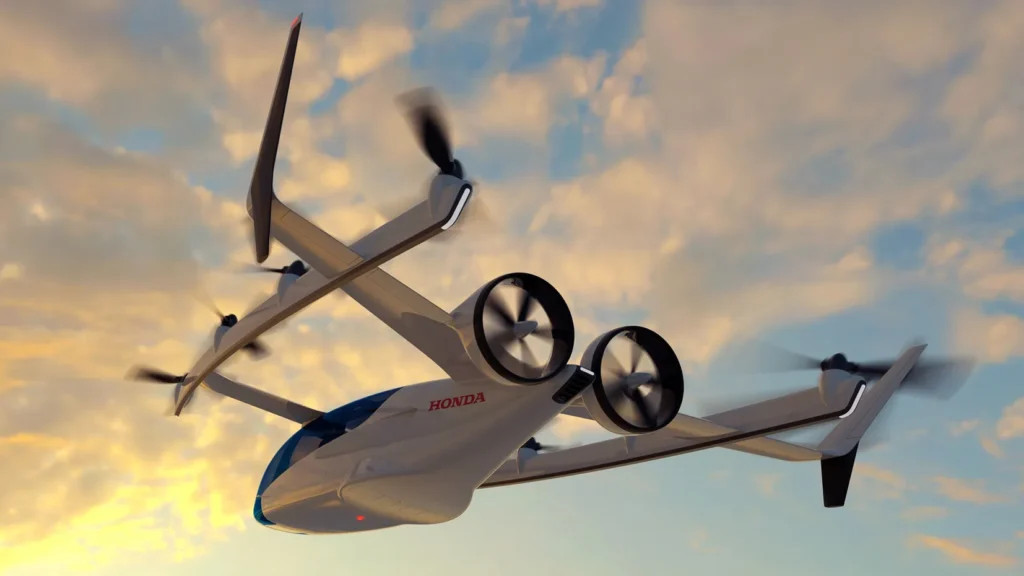 Honda_eVTOL-25
Honda_eVTOL-25
21. What Materials are Being Used to Build Flying Cars?
The materials used to build flying cars are critical for achieving the necessary strength, lightness, and durability.
- Carbon Fiber Composites: Carbon fiber composites are lightweight and strong, making them ideal for the airframe and other structural components.
- Aluminum Alloys: Aluminum alloys are also lightweight and strong, and they are often used for parts that require high stiffness.
- Titanium Alloys: Titanium alloys are strong and corrosion-resistant, making them suitable for use in high-stress and high-temperature environments.
- Advanced Plastics: Advanced plastics are used for interior components and other non-structural parts.
- Specialized Coatings: Specialized coatings are used to protect the aircraft from corrosion, wear, and other environmental factors.
The selection of materials for flying cars is a complex process that involves balancing performance, cost, and safety considerations.
22. How Will Weather Conditions Affect Flying Car Operations?
Weather conditions will have a significant impact on flying car operations:
- Visibility: Poor visibility due to fog, rain, or snow can make it difficult or impossible to fly safely.
- Wind: Strong winds can make it difficult to control flying cars, especially during takeoff and landing.
- Icing: Icing can reduce the performance of flying cars and make them more difficult to control.
- Turbulence: Turbulence can make flights uncomfortable or even dangerous.
- Lightning: Lightning strikes can damage the electrical systems of flying cars.
Flying car operators will need to carefully monitor weather conditions and adjust their operations accordingly to ensure safety.
23. What are the Ethical Considerations of Flying Cars?
The development and deployment of flying cars raise a number of ethical considerations:
- Equity: Ensuring that flying cars are accessible to all members of society, not just the wealthy.
- Privacy: Protecting the privacy of individuals from surveillance by flying cars.
- Noise Pollution: Minimizing the noise pollution generated by flying cars, especially in densely populated areas.
- Environmental Impact: Minimizing the environmental impact of flying cars, including greenhouse gas emissions and noise pollution.
- Safety: Ensuring the safety of passengers and the public.
These ethical considerations need to be addressed proactively to ensure that flying cars are developed and deployed in a responsible and sustainable manner.
24. How Will Flying Cars Change the Way We Commute?
Flying cars have the potential to revolutionize the way we commute:
- Reduced Commute Times: Flying cars can bypass ground traffic, significantly reducing commute times.
- Increased Flexibility: Flying cars can provide a more flexible and convenient way to travel, allowing people to live further from their workplaces.
- Access to New Areas: Flying cars can provide access to areas that are currently difficult to reach by traditional transportation methods.
- Personalized Transportation: Flying cars can be personalized to meet the specific needs of individual commuters.
- Reduced Stress: By reducing commute times and increasing flexibility, flying cars can help to reduce stress and improve quality of life.
While it’s unlikely that flying cars will completely replace traditional commuting methods, they have the potential to significantly alter the way we travel to and from work.
 Hyundai Supernal flying car
Hyundai Supernal flying car
25. How Can I Stay Informed About the Latest Flying Car Developments?
Staying informed about the latest flying car developments is essential for anyone interested in this exciting technology.
- Follow Industry News: Subscribe to aviation and technology news websites and publications.
- Attend Industry Events: Attend conferences and trade shows focused on urban air mobility and eVTOL technology.
- Follow Key Companies: Follow the social media accounts and websites of leading flying car companies.
- Join Online Communities: Join online forums and communities dedicated to flying cars.
- Read Research Reports: Read research reports and white papers published by industry analysts and research institutions.
By staying informed, you can keep up-to-date on the latest advancements in flying car technology and gain a deeper understanding of this rapidly evolving industry.
FAQ: Your Flying Car Questions Answered
1. Will there be flying cars in 2025?
While widespread use isn’t expected by 2025, limited commercial operations might begin.
2. How much will a flying car cost?
Early models are projected to be expensive, potentially costing hundreds of thousands of dollars.
3. Are flying cars safe?
Safety is a top priority, with redundant systems and autonomous flight features being developed.
4. Where will flying cars take off and land?
Vertiports, specialized landing pads, will be built in urban areas.
5. What powers flying cars?
Most designs focus on electric propulsion for cleaner and quieter operation.
6. Who are the leading companies developing flying cars?
XPENG, Joby Aviation, and Hyundai are among the key players.
7. What kind of training will flying car pilots need?
While many will be autonomous, pilots will require specialized training and certification.
8. How will flying cars affect traffic?
They have the potential to reduce ground traffic by utilizing airspace.
9. What are the environmental concerns surrounding flying cars?
Noise and energy consumption are key considerations.
10. Where can I learn more about flying cars?
Visit flyermedia.net for the latest news, insights, and analysis on the flying car industry.
The dream of flying cars is closer than ever, and flyermedia.net is your go-to source for staying informed about this exciting future.
Ready to take off into the world of aviation? Visit flyermedia.net today to explore flight training programs, get the latest aviation news, and discover exciting career opportunities in the skies. Your journey starts here!
Address: 600 S Clyde Morris Blvd, Daytona Beach, FL 32114, United States. Phone: +1 (386) 226-6000. Website: flyermedia.net.
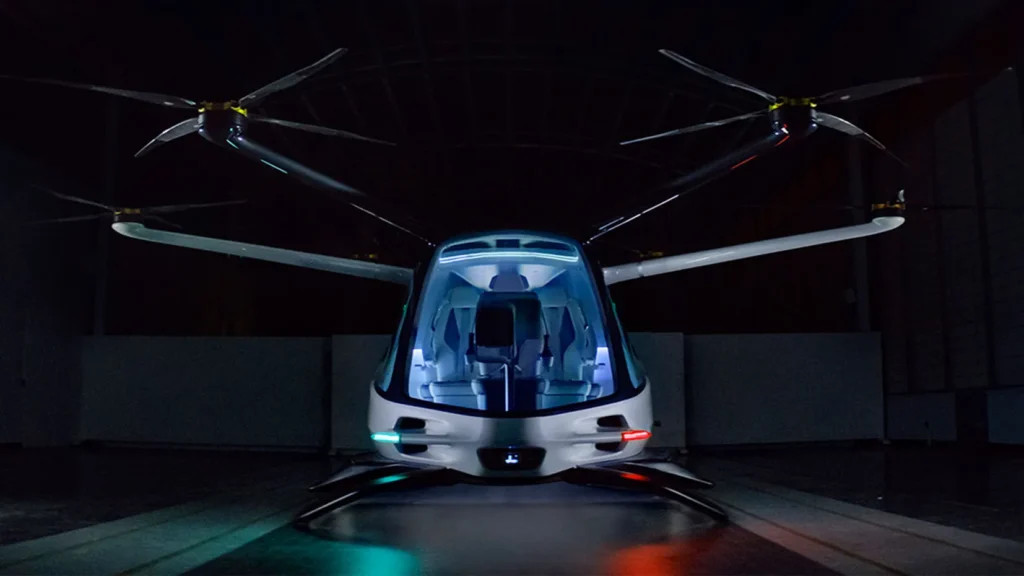 BMW Skai
BMW Skai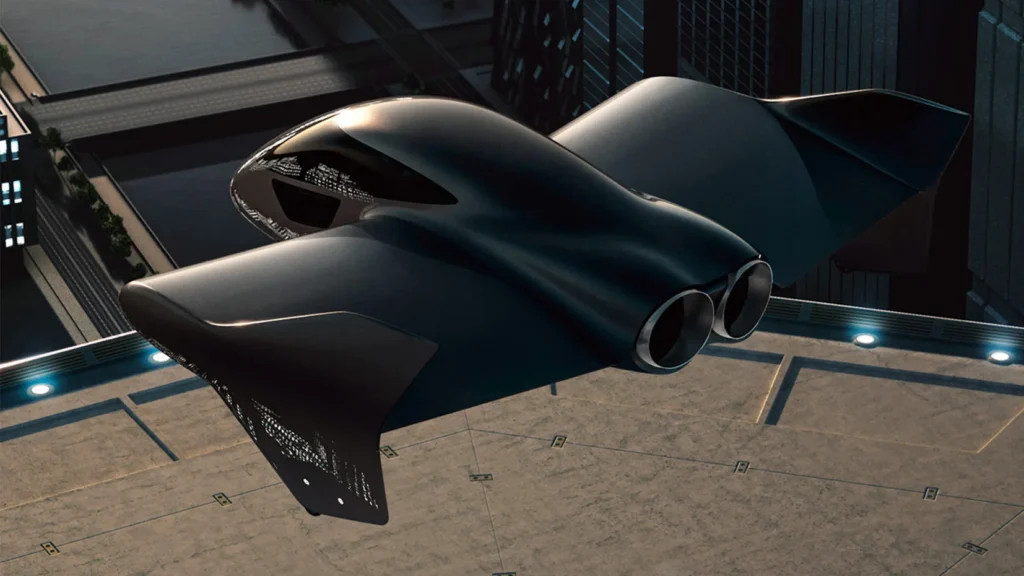 Porsche-Boeing flying car
Porsche-Boeing flying car